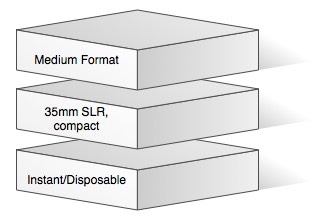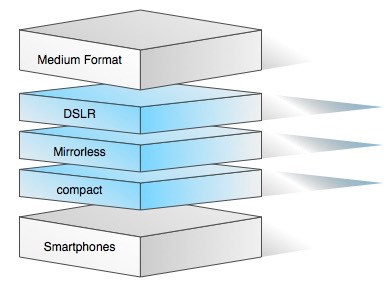Back in the heydays of the film SLR, the SLR was often considered “lower ground.” If you wanted to make the best possible images, the “higher ground” was always Medium Format (MF) or Large Format (LF). My mentor, Galen Rowell, was ridiculed by some for trying to survive in the landscape world of 120/220/6x7/+ shooters with his little Nikon 35mm SLRs. Yet he did. With aplomb. Mostly because he could get his camera to places where the big boys never ventured.

As I look around today, things are very curious in respects to what “ground” the various products occupy. For example, is the Nikon D810 “higher ground” and the Nikon D3300 “lower ground”? Or is it more that they’re both middle ground?
These days I’m thinking it’s the latter, and that’s part of the problem with DSLRs at the moment.
It seems clear that the lowest ground is smartphones (it used to be compact digital cameras, and in the film days it was instant and disposable cameras). Above that we now have very competent large-sensor compacts and the small mirrorless systems. Next comes DX/APS mirrorless and DSLRs. Then FX/full frame mirrorless and DSLRs. Then MF digital.

Note one thing: we have remarkably current Sony sensor technology in all of those choices. The iPhone 6+ uses Sony sensors, the latest Hasselblad MF camera does, too. Along with every option in between. Thus, we’re back to the same place we were with film, where the Fujifilm and Kodak offerings in APS, 35mm, 120/220, and larger formats were basically the same, with the only differential being how much you were going to blow those things up when printing. In that world, you choose your cameras based upon juggling other compromises than the film stock (image sensor) maker.
Curiously, APS didn’t really take off. It’s the equivalent of today’s m4/3 in many ways: smaller format creates smaller, more portable products. What APS didn’t manage was to get market acceptance. Some of that was, while fine for those 4x6” prints from your local one-hour processor, APS showed some image quality warts when you tried to go significantly bigger. Thus, 35mm film was the most common lower ground. Indeed, that was even true for disposable cameras, which used 35mm film. (There were other issues that came into play, such as trying to get APS developing equipment to be ubiquitous, APS film sales to be ubiquitous, plus getting people to replace perfectly fine existing cameras.)
Meanwhile, with pros MF was definitely the higher ground. As I’ve written before, when we spread image submissions on the big light tables at Rodale for selection in the magazines, the bigger slides had a real advantage over the smaller ones. It didn’t matter that the image was going to eventually be cut down to essentially an 8x10” print at a 133 line screen (not a very high bar). It’s what the photo editors saw while making their selections that influenced them greatly. So much so that one way Galen competed in this market was by making MF duplicates of his 35mm slides ;~).
To some degree, this explains the Nikon 1: Nikon foresaw compacts collapsing and that the new “low ground above smartphones” was going to be some sort of higher caliber compact. Had they just built an RX100-like Nikon 1 instead of the interchangeable lens versions they did, they would have been far better off, I think. Consider this N1 definition had it been produced in 2011: 1” sensor, 24-85mm f/2.8-4 collapsing lens, US$800. It would have been a hit. Heck, make an N2, too, with an EVF.
Of course, the Nikon 1 that Nikon actually produced had lots of "middle ground” competitive problems: it had the P7xxx series occupying where it should have been, and it had DX DSLRs living in the other place it could have been. So Nikon tried to squeeze a fourth thing into what was a rapidly narrowing middle ground. Now we’re left with CX, DX, and FX (and some compacts) that are all trying to get the attention of a smaller set of customers in the middle.
In tomorrow’s article I’ll show you a slightly different way to approach camera products, with a line from low to high that shares a key new attribute in order to rejuvenate market growth rather than uses iterative features to fight for dominance in the middle ground.





